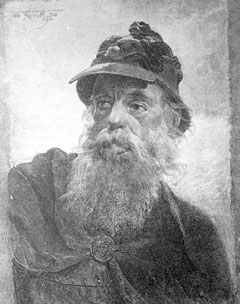Not to be confused with the Battle of Falmouth (1703)
| Battle of Falmouth (1690) | |||||||
|---|---|---|---|---|---|---|---|
| Part of King William's War | |||||||
 Baron de St Castin | |||||||
| |||||||
| Belligerents | |||||||
|
New France Wabanaki Confederacy |
| ||||||
| Commanders and leaders | |||||||
|
Joseph-François Hertel de la Fresnière Baron de St Castin Chief Hopehood(Kennebecks) Rene Robinau de Portneuf[1] Augustin Le Gardeur de Courtemanche[2] | Captain Sylvanus Davis[3][4] | ||||||
| Strength | |||||||
| 400-500 troops and natives | unknown | ||||||
| Casualties and losses | |||||||
| unknown | 200 killed | ||||||
| |||||
The Battle of Falmouth (also known as the Battle of Fort Loyal) (May 16–20, 1690) involved Joseph-François Hertel de la Fresnière and Baron de St Castin leading troops as well as the Wabanaki Confederacy (Mi'kmaq and Maliseet from Fort Meductic) in New Brunswick to capture and destroy Fort Loyal and the English settlement on the Falmouth neck (site of present-day Portland, Maine), then part of the Massachusetts Bay Colony. The commander of the fort was Captain Sylvanus Davis.[5] After two days of siege, the settlement's fort, called Fort Loyal (sometimes spelled "Loyall"), surrendered. The community's buildings were burned, including the wooden stockade fort, and its people were either killed or taken prisoner. With the fall of Fort Loyal (Casco), led to the near depopulation of Maine. Native forces were then able to attack New Hampshire frontier without reprisal.[6]
Historical context[]
The earliest garrison at Falmouth was Fort Loyal (1678) in what was then the center of town, the foot of India Street. During King William's War, on Major Benjamin Church's first expedition into Acadia, on September 21, 1689, he and 250 troops defended a group of English settlers trying to establish themselves at Falmouth, Maine (present-day Portland, Maine). Natives killed 21 of his men, however, he was successful and the natives retreated.[7] Church then returned to Boston leaving the small group of English settlers unprotected.[8] Hertel was chosen by Governor Frontenac to lead an expedition in 1690 that successfully raided Salmon Falls on the Maine-New Hampshire border, and then moved on to destroy Fort Loyal on Falmouth Neck (site of present-day Portland, Maine)
Battle[]
In May 1690, four hundred to five hundred French and Indian troops under the command of Joseph-François Hertel de la Fresnière and Baron de St Castin,[9] attacked the settlement. Grossly outnumbered, the settlers held out for four days before surrendering. Eventually two hundred were murdered and left in a large heap a few paces from what is now the popular Benkay sushi restaurant.[10] Davis was taken prisoner to Quebec.
Aftermath[]
When Church returned to the village later that summer, he buried the dead.[11]
James Alexander was taken captive along with 100 other prisoners.[12] Alexander was taken back to the Maliseet headquarters on the Saint John River at Meductic, New Brunswick. "James Alexander, a Jersey man," was, with John Gyles, tortured at an Indian village on the St. John river.[13] Two families of Mi'kmaq people, who had lost friends by some English fishermen, came these many miles to avenge themselves on the captives. They were reported to have yelled and danced around their victims; tossed and threw them; held them by the hair and beat them - sometimes with an axe - and did this all day, compelling them also to dance and sing, until at night they were thrown out exhausted. Alexander, after a second torture, ran to the woods, but hunger drove him back to his tormentors. His fate is unknown.[14]
Captain Davis spent four months as a prisoner in Canada. Both Falmouth and Arrowsic remained uninhabited until 1714 and 1716 respectively.[15]
The Fort was replaced and named Fort Falmouth in 1742 leading up to King Georges War.
See also[]
References[]
- Hull, John Thomas. The Siege and Capture of Fort Loyall
- Captain Sylvanus Davis - Canadian Biography On Line
- Captain Sylvanus Davis' account of the battle. Mass. Hist. Soc. Coll., 3d ser., I (1825), 101–12
- p. 194
Endnotes
- ↑ http://www.biographi.ca/en/bio/robinau_de_portneuf_rene_2E.html
- ↑ http://www.biographi.ca/en/bio/le_gardeur_de_courtemanche_augustin_2E.html
- ↑ p.435
- ↑ http://www.biographi.ca/en/bio.php?id_nbr=742
- ↑ Captain Sylvanus Davis was of Sheepscot in 1659 and was wounded at Arrowsick at the time Captain Lake was killed. He removed to Falmouth in 1680 and had command of the fort there in the next Indian war. He was captured and carried to Canada, May 20, 1690, and after his return in 1691 entered the Council by the Charter of William and Mary. He wrote an account of the conduct of the war which is in III Mass. Hist. Soc. Coll., Vol. I, page 101. He lived in Hull during the latter part of his life and died in 1704. — Savage.
- ↑ Conquering the American wilderness: the triumph of European warfare in ... By Guy Chet; p. 82
- ↑ Drake, The Border Wars of New England, p. 33
- ↑ The history of the great Indian war of 1675 and 1676, commonly called Philip ... By Benjamin Church, Thomas Church, Samuel Gardner Drake, pp175-176
- ↑ Webster, John Clarence. Acadia at the End of the Seventeenth Century. Saint John, NB, The New Brunswick Museum, 1979
- ↑ http://www.downeast.com/magazine/2010/may/casco-forgotten-forts
- ↑ The history of the great Indian war of 1675 and 1676, commonly called Philip ... By Benjamin Church, Thomas Church, Samuel Gardner Drake, pp175-176
- ↑ The old Meductic Fort and the Indian chapel of Saint Jean Baptiste: paper read before the New Brunswick Historical Society (1897), p. 7
- ↑ Tragedies of the Wilderness," 84.
- ↑ The New England Captives Carried to Canada by Emma Louis Coleman, p. 199
- ↑ http://www.davistownmuseum.org/publications/volume3.html#sylvina
Coordinates: 43°39′41.3″N 70°15′19.1″W / 43.661472°N 70.255306°W
The original article can be found at Battle of Falmouth (1690) and the edit history here.